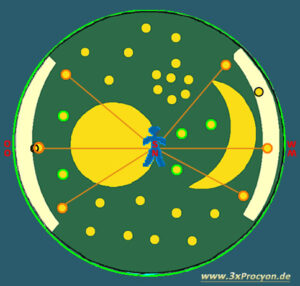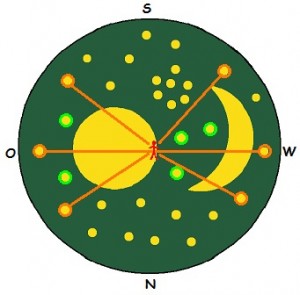With the Nebra Sky Disc the stars marked orange in the illustration are particularly conspicuous because they lie approximately in the middle and before the ends of the horizon arcs.
The visible path of the sun or the ecliptic runs through the middle of the zodiac. If we look at the sun the same time every day, it always takes four minutes longer to appear. Because of this delay, we can also observe, every three months at the same time, one of the four extreme positions, the two equinoxes and the solstices,
Rather than relying on the sun, each of these four extreme positions can be recognized much more easily with the help of a bright, almost simultaneously visible pair of stars from two different signs of the zodiac (joined by red lines in the illustration). One star revealed the beginning of the ecliptic in the east and another one revealed the end of the ecliptic in west.
In about 1950 B.C. in Central Germany, always two >ecliptic stars< stood almost exactly above the east and west points at the solstices when the high-level position or low-level position of the ecliptic occurred. During the equinoxes the eastern and western tilt could be observed in each case by a southern and a northern star.
Therefore, these pairs of stars symbolize all the extreme positions of the zodiac, which, however, were also to be seen on other nights, but not at dusk.



